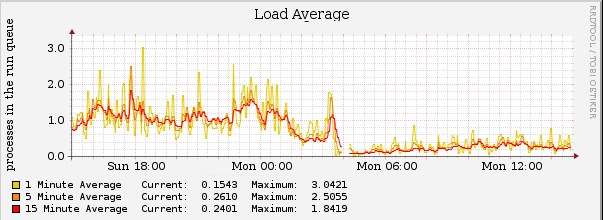One of our customers is running our ECMSquared Email server solution and recently decided they had outgrown the platform it was installed on. Mailbox access was slow, webmail was slow and it felt constantly overloaded.
When planning for an upgrade like this you have to allot for not only the hardware, but the expert’s time and this customer was on a tight budget, so they decided that spending money on our services making sure the transition was a higher priority than getting the biggest fanciest hardware rig. After all this is email, a service that may not seem critical, but it’s the first thing that people notice is not functioning correctly. So we put together a proposal for the migration.
Old system: Apple Xserve G5 – 2x 2.0Ghz G5 – 6GB RAM – 3 x 250GB SATA H/W RAID 5 running Tiger Server.
Upgrading the OS on the system from Tiger to Leopard Server should have yielded some performance gains, especially with the finer grained kernel locking that was introduced in Leopard, but with the main issue being slow mailbox access, we felt that the file system was going to continue to be the biggest bottleneck. HFS+ doesn’t handle 1000s of files in a single directory very efficiently and having the enumerate a directory like that on every delivery and every POP3/IMAP access was taking it’s toll. Also with Apple discontinuing PPC support along with the demise of the Xserve, the longevity of this hardware was assessed as low.
The decision was made to go to a Linux based system running ext3 as the file system. Obviously this opened up the hardware choices quite a bit.
A mail server is very much like a database server in that the biggest bottleneck is almost always disk throughput, not CPU or network. Based on the customers budget concerns we wanted to get them the biggest fastest drive array in the eventual system for the budget allowed. There aren’t a lot of choices when it comes to bigger/faster hard drives within a reasonable budget, so we ended up choosing a 3 x 146GB 10k rpm SCSI drives in a RAID 5 array.
New System: Dell PowerEdge 1750 – 2x 3.2Ghz Xeon – 8GB RAM – 3x 146GB NEW SCSI drives in HW RAID 5
Obviously this is relatively old hardware, but we were able to get everything procured along with some spare drives for ~$600
We installed Debian Lenny and custom-compiled version of Exim onto the system and ran several days of testing.
Then we migrated their system over late one night and everything went smoothly.
The change in that hardware/OS/file system stack produced the following graphic for the Load Average for the system:
You can see how dramatic the difference in how loaded the server was from before. The customer is very happy in the snappiness of the system now.
Even though the server hardware is a bit older, it’s applying the right resources in the right spot that makes thing run very smoothly.
We expect many more years of usage from this system.

would a hashdir type structure for the files helped with file access time and kept individual folders to <1000?